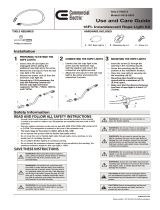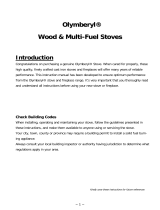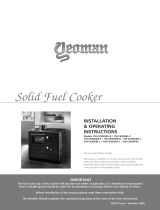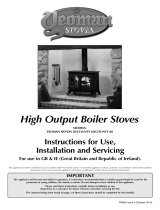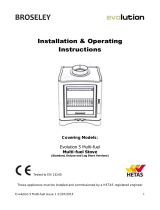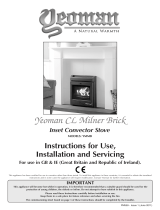Page is loading ...

PM235 - Issue 1 (May 2008)
Riva MF Cassette
MODELS: RV40/RV55/RV66/RV66AVC/RV76
Instructions for Use,
Installation and Servicing
For use in GB & IE (Great Britain and Republic of Ireland).
IMPORTANT
This appliance will become hot whilst in operation, it is therefore recommended that a suitable guard should be used for the
protection of young children, the elderly or infirm. Do not attempt to burn rubbish in this appliance.
Please read these Instructions carefully before installation or use.
Keep them in a safe place for future reference and when servicing the fire.
The commissioning sheet found on page 3 of these instructions should be completed by the Installer.
This appliance has been certified for use in countries other than those stated. To install this appliance in these countries, it is essential to obtain the translated
instructions and in some cases the appliance will require modification. Contact Stovax for further information.

COVERING THE FOLLOWING MODELS:
RV40/RV55/RV66/RV66AVC/RV76
2
APPLIANCE COMMISSIONING CHECKLIST 3
USER INSTRUCTIONS 4
General Points 4
Using the Appliance for the first time 6
Recommended Fuels 6
Lighting the appliance 7
Running the appliance 7
Burning Tips 8
Ash Removal 9
Over night burning 10
Over-Firing 10
Chimney Fire 10
General Cleaning 10
Cleaning Glass 10
Chimney Sweeping 10
Care of Stove 11
Seasonal Use 11
Troubleshooting Tips 11
INSTALLATION INSTRUCTIONS 13
Technical Specifications 13
Standard Features 13
Packing List 13
Dimensions 14
SITE REQUIREMENTS 15
Flue & Chimney 15
Flue exit positions 16
Hearth Dimensions 16
Walls Next to Hearth 17
PRE-INSTALLATION 18
Ventilation 18
Additional Ventilation 19
INSTALLATION 20
Legal Requirements 20
Installing the Appliance 20
Top Flue Installation 20
Rear Flue Installation 21
Removal of Log Guard 21
Fitting & Removal of Fire Bricks 21
Fitting & Removal of Baffles 22
Fitting & Removal of Riddling Mechanism 22
Adjusting Door Hinges 23
COMMISSIONING 24
MAINTENANCE & SERVICING 25
Annual Service 25
Removal of Log Guard 26
Removal of Fire Brick 26
Removal of Baffle 26
Removal of Riddling Mechanism 26
Fitting a New Door Glass 26
Fitting a New Door Seal 26
Adjusting Door Hinges 26
BASIC SPARE PARTS LIST 27
SERVICE RECORDS 29
EC DECLARATION OF CONFORMITY 30
This appliance has been approved by HETAS Ltd.

3
APPLIANCE COMMISSIONING CHECKLIST
To assist us in any guarantee claim please complete the following information:-
Dealer appliance was purchased from
Name: .................................................................................................................................................................
Address: ...............................................................................................................................................................
............................................................................................................................................................................
Telephone number: .............................................................................................................................................
Essential Information - MUST be completed
Date installed: .....................................................................................................................................................
Model Description: ..............................................................................................................................................
Serial number: .....................................................................................................................................................
Installation Engineer
Company name: .....................................................................................................................................................................
Address: .................................................................................................................................................................................
...............................................................................................................................................................................................
Telephone number: ................................................................................................................................................................
Commissioning Checks (to be completed and signed)
Is flue system correct for the appliance YES NO
Flue swept and soundness test complete YES NO
Smoke test completed on installed appliance YES NO
Spillage test completed YES NO
Use of appliance and operation of controls explained YES NO
Instruction book handed to customer YES NO
Signature: ....................................................................................... Print name: ...............................................................

4
USER INSTRUCTIONS
1. GENERAL POINTS
1.1 Before use of this appliance please read these
instructions fully.
1.2 All local regulations, including those referring to national
and European Standards need to be complied with when
installing the appliance.
1.3 Only use for domestic heating in accordance with these
operating instructions.
1.4 You must burn only approved fuels. Do not use with liquid
fuels or as an incinerator.
1.5 Appliance surfaces become very hot when in use. Use
a suitable fireguard if young children, elderly or infirm
persons are present.
Stovax offer firescreens, sparkguards and hearthgate systems
for protection*. Your Stovax dealer can advise you about
these products.
1.6 Do not place photographs, TV’s, paintings, porcelain or
other combustible items on the wall or near the appliance.
Exposure to hot temperatures will cause damage.
1.7 Extractor fans or cooker hoods must not be placed in the
same room or space as this can cause appliance to emit
fumes into the room.
1.8 Do not obstruct inside or outside ventilation required for
the safe use of this appliance.
1.9 Do not make unauthorised changes to the appliance.
1.10 The chimney must be swept at least once a year.
See Section 12
1.11 Do not connect, or share, the same flue or chimney
system with another appliance.
SERIAL NUMBER
1.12 This number is required when ordering spare parts or
making warranty claims.
It is found as shown.
Riva
PRODUCT:
MODEL No.
SERIAL No.
PR7029
Riva Avanti
PRODUCT:
MODEL No.
SERIAL No.
AIR CONTROLS
Cleanburn Technology and Convector Efficiency
Riva appliances incorporate the latest cleanburn technology
with a unique 'Opti-Burn' setting in order to burn fuels with
greater efficiency.
See Diagram 3.
1) Primary Air - burns the fuel under the fuel bed. For use
with solid fuel and initially with wood fires.
2) Airwash - air drawn over the window cleans the glass.
The source of Primary Combustion air when burning wood.
3) Unique 'Opti-Burn' setting provides optimum efficiency
and visual effect.
*In the U.K: These products must conform to BS 6539,
Fireguards for use with solid fuel appliances.
If appliance is operating unattended they must conform to
BS 3248

5
USER INSTRUCTIONS
4) Clean burn - Secondary air is preheated through a heat
exchanger to combust unburned hydrocarbons, providing a
cleaner and more efficient burn.
5) Convected and radiant heat.
Move air control as shown
using the door tool.
This control has a pre-set
"indent ball" stop in the closed
position "opti-burn" setting.
If the control is pushed past
this point the airwash will be
fully closed.
PRIMARY AIR CONTROL AIRWASH AIR CONTROL
PR7053
PR7003PR7034
RIVA
This control has a pre-set
"indent ball" stop in the closed
position "opti-burn" setting.
If the control is pushed past
this point the airwash will be
fully closed.
PRIMARY AIR CONTROL AIRWASH AIR CONTROL
PR7046
PR7047PR7048
RIVA AVANTI
DOOR HANDLE
1.13 Use a protected gloved hand to operate.
See Diagram
DO NOT OPEN THE DOOR WITH BARE HANDS
1.14 Riva 66
To remove the door handle:
•Liftthehandlewithoutrotating
1.15 To open the door:
•Pullthelowerportionofthehandle
To close the door:
•Holdthehandleintheopenpositionandpushthedoor
to the closed position
•Rotatethehandletotheverticalposition

6
USER INSTRUCTIONS
1.16 Riva 66 Avanti
To open and close the door:
•Usethetoolprovided,seeDiagram
Remove
Pull to open
RIVA
Lift to Open
Remove
RIVA AVANTI
PR7049
WARNING
Properly installed, operated and maintained this
appliance will not emit fumes into the room.
Occasional fumes from de-ashing and refuelling may occur.
Persistent fume emission is potentially dangerous and
must not be tolerated.
If fume emission does persist:
•Opendoorsandwindowstoventilatetheroom
•Allowfiretoburnoutorsafelydisposeoffuelfromthe
appliance
•Leavetheroom
•Checkforchimneyblockageandcleanifrequired
•Donotattempttorelightuntilthecauseoftheemission
has been identified and corrected
If necessary seek expert advice.
2. USING THE APPLIANCE FOR THE FIRST
TIME
2.1 To allow the appliance to settle and fixing glues and paint to
fully cure:
•Operatetheapplianceatalowoutputforfirstfewdays
2.2 Do not touch the paint during the first period of use.
2.3 During this time the appliance may give off some
unpleasant odours:
•Keeptheroomwellventilatedtoavoidabuild-upof
fumes
3. RECOMMENDED FUELS
3.1 Wood Logs:
•Burnonlyseasonedtimberwithamoisturecontentofless
than 20%
Wood Length
Appliance Wood Length
Riva 40 250mmm
Riva 55 350mm
Riva 66 450mm
Riva 66 Avanti 450mm
Riva 76 510mm
•Drycutwoodfor12to18monthsbeforeuse
Poor quality timber:
— Causes low combustion efficiency
— Produces harmful condensation
— Reduces effectiveness of the airwash and life of the
appliance
Do not burn construction timber, painted, impregnated
/ treated wood, manufactured board products or pallet
wood.

7
USER INSTRUCTIONS
3.2 Solid fuel:
•Burnonlyanthraciteormanufacturedbriquettesmokeless
fuels listed as suitable for use with closed heating appliances
Do not burn bituminous coal, ‘petro-coke’ or other
petroleum based fuels as this will invalidate the product
guarantee.
3.3 Fuel consumption.
As tested at nominal heat output to the requirements of EN
13240: 2001 for intermittent operation:
Description
Fuel Consumption
Kg/hour
Wood
Kg/hour
Briquette
Smokeless fuel
Riva 40 1.6 0.8
Riva 55 2.4 1.2
Riva 66 2.6 1.2
Riva 66 Avanti 2.6 1.2
Riva 76 3.3 N/A
3.4 For advice on suitable solid fuels:*
•Contactyourlocalapprovedcoalmerchant
A number of factors can affect the performance of the
appliance. See Section 8 for details.
4. LIGHTING THE APPLIANCE
4.1 For best results:
•Setaircontrols,SeeDiagram
PRIMARY AIR CONTROL AIRWASH AIR CONTROL
PR7047PR7048
RIVA AVANTI
Open 25%
Open Fully
PRIMARY AIR CONTROL AIRWASH AIR CONTROL
PR7003PR7034
RIVA
Open 25%
Open Fully
Ashpan
Tool
•Placefirelightersorpaperanddrykindlingwoodonthe
grate
•Lightthepaperorfirelighters,SeeDiagram6
•Leavethedoorslightlyopenasthefireestablishesand
the glass warms to avoid the build-up of condensation
•Addlargerpiecesofwood
Too many logs may smother the fire.
Do not load fuel above the log guard and the secondary
combustion inlets at the back of the firebox.
See Diagram 7
Air Inlets
Log Guard
•Closethedoor
Do not leave the door open as this could over-fire and
damage the appliance.
*In the U.K:
•RingtheSolidFuelAssociationadvicelineon
0845 601 4406 for details
•Visittheirwebsiteatwww.solidfuel.co.uk

8
USER INSTRUCTIONS
5.6 Burning Solid fuel (Not applicable for Riva 76):
•Setaircontrols,SeeDiagram
PRIMARY AIR CONTROL AIRWASH AIR CONTROL
PR7003PR7034
RIVA
PRIMARY AIR CONTROL AIRWASH AIR CONTROL
PR7047PR7048
RIVA AVANTI
Open Fully
Open Fully
Open 25%
Open 25%
5.7 When the fire becomes established reduce the Airwash air
control to approximately 25% open and control the burn
rate using the Primary air control only.
5.8 De-ash the fire bed before re-fuelling, see Ash Removal,
Section 7.
•OpenthePrimary air control fully to establish a glowing
bed before adding new fuel
•Burnnewfuelathighoutputforafewminutesbefore
adjusting the Primary air control to the desired setting
•Refuellittleandoftenforclean,efficientburning.
5.9 Experience establishes control settings to suit personal
preferences
5.10 Do not burn large amounts of fuel with the Primary Air
Control on low settings for long periods of time. This
reduces the glass cleaning effect of the air wash and causes
tars and creosotes to build-up in the appliance and flue
system.
5.11 When in use, burning the appliance at high output for a
short period also reduces tars and creosote.
5.12 You must burn only anthracite or smokeless fuels
suitable for use in closed appliances.
5.13 Do not burn bituminous coal, ‘petro-coke’ or other
petroleum based fuels as this invalidates the product
guarantee.
Do not load fuel above the log guard and the secondary
combustion inlets at the back of the firebox.
See Diagram 7
5. RUNNING THE APPLIANCE
5.1 Burning Wood:
•ClosethePrimary air control (multi-fuel versions only)
and use the Airwash to control the burn rate when
appliance is at operating temperature, see Diagram
PRIMARY AIR CONTROL AIRWASH AIR CONTROL
PR7003PR7034
RIVA
PRIMARY AIR CONTROL AIRWASH AIR CONTROL
PR7047PR7048
RIVA AVANTI
Adjust
Adjust
Close
Close
Ashpan
Tool
•Woodburnsbestonabedofash
•Raketheembersevenlyoverthefirebedandopenthe
Airwash control fully for a few minutes before re-fuelling
5.2 Burn new logs at high output for a few minutes before
adjusting the Airwash control. Refuel little and often for
clean, efficient burning.
5.3 Experience establishes settings to suit personal preferences.
5.4 Do not burn large amounts of fuel with the Airwash control
closed for long periods of time. This reduces the glass
cleaning effect and causes tars and creosotes to build-up in
the appliance and flue system.
5.5 When in use, burning the appliance at high output for a
short period also reduces tars and creosote.

9
USER INSTRUCTIONS
6. BURNING TIPS
6.1 Fuel Quality (Wood)
Use wood with a moisture content of less than 20%.
Seasoned logs have the bark beginning to lift and peel away
and cracks radiating from the centre. They feel lighter than
fresh cut wood of a similar size and sound hollow when
struck against each other. Logs should not feel damp or
have moss and fungal growths.
Symptoms related to wet wood:
— Difficulty starting and keeping a fire burning well
— Smoke and small flames
— Dirty glass and/or firebricks
— Rapid creosote build-up in the chimney
— Low heat output
— Short burn times, excessive fuel consumption and
blue/grey smoke from the chimney
•Burn at high output at high output for a short period each
day to avoid large build-ups of tars and creosote within the
appliance and the flue system
•Use Stovax Protector chimney cleaner to reduce this
problem
6.2 Fuel Quality (Solid Fuel)
•Use recommended solid fuels approved for use with
closed appliances.
Symptoms related to unsuitable fuels include:
— Difficulty starting and keeping a fire burning well
— Smoke and small flames
— Dirty glass and/or fire bricks
— Short life span for grate, baffles and internal firebricks
— Permanent staining of glass
6.3 Air inlets puffing smoke
Combustion gases build up in the firebox and ignite as small
explosions, causing smoke to puff out of the air inlets and
other openings. This occurs if the air controls are shut soon
after adding new fuel to a very hot fire. Stop by opening the
air controls to increase combustion air and burning rate.
6.4 Flue Draught
The chimney has two main functions:
1) To safely remove the smoke, gases and fumes from the
house.
2) To provide a sufficient amount of draught (suction) in the
appliance ensuring the fire keeps burning.
Draught is caused by the rising hot air in the chimney when
the appliance is lit.
Symptoms of poor performance related to flue draught
include:
— Excessive fuel consumption (high flue draught)
— Poor burning control, overheating (high flue draught)
— Wind noise from air controls (high flue draught)
— Difficulty getting a fire going and keeping it burning well
(low flue draught)
— Low heat output (low flue draught)
— Smoke entering room when doors opened (low flue
draught)
The construction, position, size and height of the chimney
all affect the performance of the flue draught.
Other factors effecting the flue draught include:
— Trees or other buildings nearby causing turbulence
— High and gusty winds
— Outside temperature
— Outside weather conditions
— Incorrect additional ventilation to building
— Blocked flue / chimney
For advice on the correction of persistent flue problems
consult a qualified solid fuel heating engineer before
continuing to use the appliance.
6.5 Weather conditions
The weather conditions outside the building can effect the
burning performance of the appliance. These could include:
Weather Conditions Problem Effect
Windy days
Buildings/Obstacles
cause turbulent air
around chimney.
Smoky Appliance
Calm days
Oversized Chimney. Smoky Appliance
Damp / Rainy days
Flue temperature
not hot enough.
Rain water inside
chimney.
Lighting and
burning problems
To reduce these problems:
•Usegoodqualitykindlingwoodtostartthefire
•Burninitiallyatahightemperatureforashortperiod
•Fitaraincowltothechimney
Your installer should advise you on possible solutions.
If the appliance emits smoke into the room continuously:
•Closetheaircontrolsandallowtheappliancetogoout
•Ventilatetheroomtoclearthefumes
•Leavetheroom
Do not re-light the appliance until the problem is solved.

10
7. ASH REMOVAL
7.1 All fuels:
•OpenAshpanCover(Riva66only),SeeDiagram8
8
Riva
Ashpan Cover
Riva Avanti
PR7051
9
•RemoveAshpancarefully.Heatcanremainlongafteruse
•Usegloves,orplacetheashintoaStovaxAshCaddy
(Stovax Part No. 4227)
•Removeashatleastonceeveryweek
•Donotplacehotashinabinmadefromplasticorany
other combustible material.
8. OVER NIGHT BURNING
8.1 It is possible to get the appliance to burn over night.
In order to do this:
•De-ashpriortofinalrefuelling
•Setaircontrolstolowcombustionsettings
This will blacken the glass over night but it will clear when
operated at high output for a short period.
•Usesmokelessfuelorsmall,thicklogsdependingonfuel
desired
USER INSTRUCTIONS
9. OVER-FIRING
9.1 Do not over-fill with fuel or use at maximum output for
long periods or over-firing can occur. If the flue pipe, flue
collar or top plate glow red the appliance is over-firing:
•Close the air controls to reduce the output
9.2 Over-firing can cause permanent damage to the appliance.
10. CHIMNEY FIRE
10.1 If a chimney fire occurs:
•Shut all air controls immediately
•Evacuate the building
•Call the fire brigade
•Do not re-enter the building until it is confirmed safe
10.2 Do not use the appliance after a chimney fire until:
a) It has been inspected by a registered installer,
confirming the appliance is safe to use*
b) The chimney system inspected and swept by a chimney
sweep, confirming the system is structurally sound and free
from obstruction before re-use.**
c) It is repaired as required before re-use. Use only
genuine Stovax replacement parts to keep your appliance in
safe and efficient working order.
11. GENERAL CLEANING
11.1 Allow appliance to cool thoroughly to avoid risk of burns:
•Cleanregularly,accordingtothelevelofuse
•Giveattentiontothebafflesystem,fluewaysand
removing ash
Regular cleaning and maintenance will help give many years
of safe use.
To refresh painted finishes use Stovax Thermolac paint.
•Cleanfinishesusingwarmsoapywaterandasoftclean
cloth
•Donotuseaerosolspraysnearanoperatingappliance
Wipe dry with a soft clean cloth before re-lighting. Do not
In the U.K:
* registered with HETAS (GB only)/INFO (Republic of
Ireland only)
**This should be done by a NACS registered (UK only)/
INFO registered (Eire only) chimney sweep, who will issue
you with a certificate.

11
14. CARE OF STOVE
Stovax has a range of cleaning and maintenance products and
accessories to keep your appliance in good working condition.
Your Stovax retailer can provide full details but here is a brief list of
useful items:
Product Code Description
3047 Extra long matches
5039 Gas lighter
4052 Log basket
3048 Wood sling - for easy carrying of logs
3016 Log tongs
4027 Extra long protective gloves
5038 Hearthgate - 5 section (for areas 1780x610mm
5044 Hearthgate - 7 section (for areas 1780x405mm)
4227 Ash caddy - 382x102x306mm
4228 Ash caddy - 446x102x306mm
4229 Ash caddy - 382x102x459mm
4230 Ash caddy - 637x127x408mm
4231 Ash caddy - 306x178x459mm
2091 Ashclean vacuum cleaner attachment
4232 Steel brush
Your retailer can provide genuine spare parts such as replacement
glass,doorsealingropeandrebrickswhenrequired.Anannual
service by a competent engineer is recommended to keep your
appliance in best possible condition.
USER INSTRUCTIONS
leave unit without drying, as this may cause rust.
Do not use abrasive cleaner or cleaning pads to clean
enamel finishes.
12. CLEANING GLASS
•KeeptheglasscleanwithcorrectuseoftheAirwashsystem
and good quality fuel
Sometimes additional cleaning may be required.
12.1 This can be done as follows:
•Allowappliancetocoolfully
Do not clean hot glass.
•UseasoftclothandStovaxGlassCleaner
12.2 Before re-lighting the appliance:
•Drytheglassfully
12.3 Do not use abrasive cleaner or cleaning pads.
Do not allow glass cleaner to come in contact with any
painted or metal surface as it can damage the finish.
13. CHIMNEY SWEEPING
13.1 To maintain safe and efficient use of the appliance the
chimney/flue must be inspected and swept at least once a
year by a qualified chimney sweep.**
If the appliance is used continuously throughout the year
or it is used to burn wood or smokeless fuel, more frequent
sweeping is recommended.
The best time to have the chimney swept is at the start of
the heating season.
The above applies even if burning smokeless fuels.
13.2 The chimney, any connecting flue pipe and the appliance
flue ways if incorporated, must be regularly cleaned.
13.3 Ensure adequate access to cleaning doors where it is not
possible to sweep through the chimney.
13.4 If the appliance is believe to have previously served an
open fire the chimney must be swept a second time within
a month of regular use after installation.
In the U.K:
* registered with HETAS (GB only)/INFO (Republic of
Ireland only)
**This should be done by a NACS registered (UK only)/
INFO registered (Eire only) chimney sweep, who will issue
you with a certificate.

12
•Glassblackening
•Thick,brownandstickytaroozesfromthepipejoints
This is caused by burning damp wood and burning your
appliance at too low a temperature;
•Usewellseasonedwoodandoperatetheapplianceinthe
ideal temperature range
Tar is a major cause of chimney fires - if you experience
problems with tar build up consult a chimney sweep before
continued use of your appliance.
Ideal working temperature range is 130°C and 240°C
(270°F – 465°F). Failing to close down the primary air
control once the appliance has heated up to this range
may cause the appliance to over-fire and to exceed the
ideal temperature range. Over-firing can cause permanent
damage to the appliance and invalidates your warranty.
USER INSTRUCTIONS
15. SEASONAL USE
15.1 Clean and service the appliance if it is not used during the
warmer periods of the year as detailed in the Maintenance
and Servicing section
15.2 Set the air controls 50% open to keep the appliance
ventilated and stop the build-up of any moisture inside.
15.3 Before re-lighting the appliance:
•Remove the baffles
•Clear any debris that may have accumulated
•Check the flue is clear of any blockages
16. TROUBLESHOOTING TIPS
16.1 Stove glass blackening:
This has four possible causes:
1. Incorrect use of airwash – See Sections 1, 4 and 5 for the
correct use of the air controls.
2. Burning unseasoned wood – See Section 3 to identify
when wood is ready for burning.
3. Stove operated at too low a temperature - good working
temperature is 300-500° F (120 – 250° C). A stove pipe
thermometer can identify this problem (Stovax part no
3046)
•Burnwiththeairwashcontrolfullyopenforapproximately
20 minutes to cure this
The problem may be caused by damping your appliance
down overnight.
4. Problems with the flue – in particular insufficient air pull.
If the flue is not working efficiently the glass can blacken.
A flue which has too much downdraft may be too short or
needs lining or has too many bends. This can also cause
blackening of your stove glass. Contact the installer or a flue
specialist for advice.
16.2 Riddling mechanism jamming:
This occurs when fine ash builds up under the riddling bars
preventing movement. To prevent this:
•Followaregularcleaningroutinefortheinsideofyour
appliance
•Liftouttheriddlingmechanismandremoveallash
•Replaceriddlingmechanismwhencleaningiscomplete
16.3 Glass cracking:
Do not over tighten the screws on the glass clips when
replacing the glass as this causes stress and the intense
temperature changes can cause the glass to crack. For
replacement glass contact your local Stovax dealer.
16.4 Appliance is producing tar:
This is identified by:
•Averystrongpungentsmellshortlyaftertheapplianceis
lit and heats up

13
TECHNICAL SPECIFICATION
STANDARD FEATURES
•Primaryair(undergrateairforfullmultifueluse)
•Airwash(forwoodburning/cleanglass)
•Pre-setsecondaryaircontrol(toensurecomplete
burning of flue gases)
•Riddlinggratesystemforcleande-ashing
•Stainlesssteelashpan
•Removabledoorhandle
•Interchangeabletrim/frameoptions
•Pre-drilledconvectionairductconnectionpoints(not
Riva 40)
•Optionalfanconvectionkit-mustbefittedbefore
installation only (not Riva 40)
•Spacerframekit-tosuit350mmdeepopening
(Riva 66 and 76 only)
PACKING LIST
•UserInstructions
•InstallerInstructions
•Guaranteecard
•Accessorycatalogue
•Pairleatherstovegloves
•Fixingkit(2xrawlplugs+2xcoachscrews)
•2.5mmA/FHexsocketkey
•4mmA/FHexSocketKey
•5mmA/FHexSocketKey
•Doortool
•Riddlingtool
Model
Riva 40-RV 40/RV40B
Riva 55-RV 55/RV55B
Riva 66-RV 66/RV66B
Riva 66 Avanti-RV66AVC
Riva 76/RV76
Nominal Heat Output
Wood kW 4.9 8 8 8 9.5
Solid Fuel kW 4.9 8 8 8 N/A
Flue Draught at Nominal Heat All Fuels
mm 1.5 1.5 1.5 1.5 1.5
inch Wg 0.05 0.05 0.05 0.05 0.05
Flue Gas Mass Flow
Wood g/s 5.8 8.3 7.4 7.4 10.8
Solid Fuel g/s 5.2 9.9 8.1 8.1 N/A
Flue Gas Temperature at Spigot/Socket
Wood °C 444 492 388 388 406
Solid Fuel °C 444 492 388 388 N/A
Flue Outlet Size
mm 128 128 150 150 150
inch 5 5 6 6 6
Weight
kg 70 90 101 121 125
Recommended Fuel
Wood Seasoned wood (less than 20% moisture content)
Solid Fuel
Briqette smokeless fuel suitable for closed appliances
(Ancit - Phurnacite - Taybrite - Homefire ovals)
As tested to the requirements of EN 13229:2001 for intermittent operation
Riva 40
Riva 55
Riva 66
Riva 66 Avanti
Riva 76
RIVA MF CASSETTE

14
RIVA DIMENSIONS
All dimensions in mm. (25.4 mm = 1”)
TECHNICAL SPECIFICATION
*
*
Riva
Riva Avanti
PR7041
Riva 40
RV40
Riva 55
RV55
Riva 66
RV66
Riva 66 Avanti
RV66 AVC
Riva 76
RV76
A 400mm 540mm 650mm 650mm 760mm
B 550mm 660mm 550mm 550mm 630mm
C 350mm 350mm 395mm 395mm 395mm
D 492mm 632mm 742mm 694mm 862mm
E 599mm 709mm 599mm 636mm 678mm
F 234mm 234mm 248mm 248mm 248mm
G N/A 360mm 420mm 420mm 540mm
H 128mm 128mm 153mm 153mm 153mm
J N/A N/A N/A 480mm N/A
K N/A N/A N/A 755mm N/A
L N/A 234mm 248mm 248mm 208mm

15
1. FLUE OR CHIMNEY
1.1 The flue or chimney system must be in good condition.
It must be inspected by a competent person and passed for
use with the appliance before installation
Products of combustion entering the room can cause
serious health risks.
1.2 You must check the following:
— The construction of the masonry chimneys, flue block
chimneys and connecting flue pipe system must meet the
requirements of the Building Regulations†
— A flexible flue liner system can be used if certified for
use with solid fuel systems and installation complies with
manufacturer’s instructions and Building Regulations.
The flue liner must be replaced when an appliance is
replaced unless proven to be recently installed and in good
condition.
— If it is necessary to fit a register plate it must conform to
the Building Regulations†
— The minimum height of the flue or chimney must
be 4.5m from the hearth to the top of the flue, with no
horizontal sections, a maximum of 4 bends with angles of
less than 45 degrees
— Enure the connecting flue pipe it kept a suitable
distance from any combustible material and does not form
part of the supporting structure of the building
— Make provision to remove the appliance without the
need to dismantle the chimney
— Any existing flue must be confirmed as suitable for the
new intended use as defined in the Building Regulations
— The flue or chimney systems must be inspected and
swept to confirm the system is structurally sound and free
from obstructions**
— If the chimney is believe to have previously served an
open fire the chimney must be swept a second time within
a month of regular use after installation to clear any soots
falls that may occurred due to difference in combustion
levels.
— The flue exit from the building must comply with local
building control rules.†
— Do not connect or share the flue or chimney system
with another heating appliance
1.3 Do not connect to systems containing large voids or over
230mm square.
1.4 You must provide suitable access to enable the collection
and removal of debris.
1.5 You must be able to sweep and inspect the flue when the
appliance is installed.
1.6 You must check the flue draught with all windows and
doors closed and any extraction fans in this or adjoining
rooms running at maximum speed. (See next section for
additional ventilation requirements)
Max. Draught = 2.0mm Wg
Min. Draught = 1.0mm Wg
SITE REQUIREMENTS
In the U.K:
*BS 6461: Part 1, and the requirements of Building
Regulations
**This should be done by a NACS registered (UK only)/
INFO registered (Eire only) chimney sweep, who will issue
you with a certificate.
† Building Regulations Document J
Flue Plate:
Where a hearth, fireplace, flue or chimney is provided
or extended (including cases where a flue is provided
as part of refurbishment work), information essential
to the correct appliance and use of these should be
permanently posted in the building, to meet Requirement
J4 of the Building Regulations (England and Wales), F3.12
(Scotland).
† Building Regulations Document J
Additional:
A new factory made system that complies to EN 1856; Part 1
can be used providing installation is to the requirements of:
i) BS 7566 Parts 1 -4
ii) the manufacturer's instructions
iii) Building Regulations.
For a guide containing information on Chimneys and Flues
contact:
The British Flue & Chimney Manufacturers’ Association,
FETA
2 Waltham Court
Milley Lane
Hare Hatch
Reading
Berkshire RG10 9TH
Tel: 0118 9403416 e-mail: [email protected]

16
SITE REQUIREMENTS
Position On Roof Minimum Clearances
A
On ridge or within 600mm 600mm above ridge
B
Elsewhere on roof 2300mm horizontally from roof surface and:
a) 1000mm above highest point of flue exit from roof or
b) as high as the ridge
C
On pitched, within 2300mm horizontally to
openable window, dormer
1000mm above top of opening
D
Within 2300mm of another building 600mm above top of building
1. FLUE OUTLET POSITIONS
150mm
max
Vertical
Measurement
Terminal
Insulation
Flue
Horizontal
Measurement
Adjacent
Building
The vertical measurement is the lowest from either the
point of discharge or 150mm above insulation.
IMPORTANT: Seek
specialist advice if installing
in a dwelling with a
thatched roof
2. MINIMUM DIMENSIONS - HEARTH
2.1 The appliance must stand on a non-combustible
constructional hearth which is at least 125mm thick with
the minimum dimensions as shown in diagram. If it is to be
fitted in a raised setting consideration may need to be given
to extending the depth of the hearth to safely containing
any falling logs or embers.
2.2 The building must have a suitable load-bearing capacity for
the hearth and appliance.
•Consultastructuralengineerforadvicebeforeproceeding
2.3 When fitting into an existing hearth check:
•Thattheappliancecomplieswithcurrentconstruction
regulations and is at least the minimum sizes shown
2.4 If there is no existing fireplace or chimney it is possible to
construct a suitable non-combustible housing and hearth
setting. The flue must be installed in accordance with all
local and national regulations and current rules in force .
•Checkifaddinganewchimneytoyourpropertyrequires
planning permission
2.5 Some houses are built using a timber frame construction
with high levels of thermal insulation. Isolate the appliance
from combustible materials, and provide sufficient
ventilation to maintain the heating efficiency.
Constructional hearth
1
Superimposed hearth
or
area to be free of
combustible material
Riva 40 Riva 55 Riva 66 Riva 66 Avanti Riva 76
RV40 RV55 RV66 RV66 AVC RV76
A
792mm
932mm
1042mm
1042mm
1162mm

17
SITE REQUIREMENTS
4. MINIMUM BUILDERS OPENING
To make installation easier make the opening larger than
the minimum requirements where possible.
*see note
†
Riva 55/66/76 only
If optional convection air ducts are to be used, increase the
opening height by 300mm to enable connection to be made
before final completion of building work.
Riva 66/76 only
Dimension C may be reduced to 355mm when using the
spacer frame kit.
Consideration must be given for the clearance of 20mm
between the flue pipe and lintel/inside chimney breast
5. RIVA MF CASSETTE
Riva 40 Riva 55 Riva 66 Riva 66 Avanti Riva 76
RV40 RV55 RV66 RV66 AVC RV76
A 410mm 550mm 660mm 660mm 770mm
B 560mm 670mm 560mm 560mm 640mm
C
†
360mm 360mm 405mm* 405mm* 405mm*
* Riva 66/76 only
†
Dimension C may be reduced to 355mm when using the spacer
frame kit.
For information on frames available, please contact your local
retailer or call Stovax Ltd on 01392 474011
Consideration must be given for the clearance of 20mm between
the flue pipe and lintel/inside chimney breast.
* In the U.K
Additional information covering the installation the
appliance may be found in the following British Standards:-
BS6461, BS6999, BS8303.
6. BUILDERS OPENING
Many fireplace openings have a supporting lintel. Remove
the covering plaster to identify it's position before starting
any constructive work. Do not remove constructional lintels
without making provision to support the remaining structure
of the building. The appliance must not form any part of the
supporting structure.
6.1 The chimney/flue must have a sealed connection to the
appliance flue spigot.
6.2 The structure of the builders opening will reach high
temperatures. Use insulating blockwork to reduce the heat
transfer to the external walls, in particular the area of the
chimney breast above the opening.
6.3 Take care when finishing the chimney breast and
surrounding area. The conducted and convected heat
emitted by the appliance could be high enough to crack
normal plaster. Use a high temperature plaster, or face
the area with a suitable high temperature plasterboard.
New plaster should be fully dried before the appliance is
used, or cracking could occur.
Riva 40 only
It is possible to fit the Riva 40 into an existing, traditional, 16”
fireplace opening following the removal of any existing milner
fireback. Following the removal of the fireback and any flaunching
above, the builders opening should be checked and made good to
the dimensions shown in the table. Care should be taken to ensure
the existing chimney is in good condition and that it is possible to
make the required sealed fluepipe connections to this when the
Riva 40 is installed.
If you are in any doubt about your ability to produce a safe
opening contact your Stovax dealer for professional advice.*
Riva 55/66/76 only
Should you wish to connect air ducting to the convection system,
provision should be made to increase the opening height by an
additional 300mm. This will allow the access needed to fit the
duct pipes after connecting the flue system.

18
SITE REQUIREMENTS
7. FIRE SURROUND CLEARANCES
If the appliance is to be fitted with a fire surround, use
the minimum clearances, see Diagram, between any
point of the appliance and any combustible material.
Stovax produce a selection of surrounds and details can be
obtained from your local supplier.
PR7008
7.1 We recommend you obtain expert advice before
proceeding with work of this nature.
7.2 Some finishes may discolour with heat and some lower
quality products may distort, or crack, when in use.
If stone / granite / marble or any other natural material
is used to construct the fire surround, or any part of it,
provision should be made for expansion and movement
of the parts due to heating and cooling.
If you are in any doubt about the installation
requirements, or suitablity of fire surrounds contact your
Stovax dealer.
7.3 All fire surrounds should be suitable for use with solid fuel
heating products.

19
PRE-INSTALLATION CHECKS
1. VENTILATION
1.1 This appliance requires ventilation to supply combustion air.
Any room containing the appliance must have a permanent
air vent opening with a total free area of at least 550mm
2
per kW of appliance rated output above 5kW.
1.2 Increase air supply provisions where a room contains
multiple appliances.
1.3 If vents open into adjoining rooms or spaces there must be
an air vent of at least the same size direct to the outside.
1.4 Permanent air vents should be non-adjustable and
positioned where they are unlikely to become blocked.
1.5 Site the vents where cold draught is unlikely to cause
discomfort. This can be avoided by placing vents near
ceilings or close to the appliance, see Diagram opposite.
Without liner system (round)
mm 150 150 150 150 150
minimum dimension (dia.)
inch 6 6 6 6 6
Flue/Chimney Size
Without liner system (square)
mm 135 135 135 135 135
minimum dimension inch 5
1
/
2
5
1
/
2
5
1
/
2
5
1
/
2
5
1
/
2
Liner or factory made system (dia.)
mm
†
150 150 150 150 150
installed in accordance with manufacturers instructions
inch
†
6 6 6 6 6
Riva 40
Riva 55
Riva 66
Riva 66 Avanti
* When measured from the top of the stove to the top of the flue, with no horizontal sections
and a maximum of 4 bends with angles of less than 45°
†May be 125mm (5”) if only burning low volatiles (smokeless) fuels approved for use in Smoke Contol Areas.
See web site http://uksmokecontrolareas.co.uk for more information about approved fuels.
Model
Riva 40-RV 40/RV40B
Riva 55-RV 55/RV55B
Riva 66-RV 66/RV66B
Riva 66 Avanti-RV66 AVC
Riva 66-RV76/RV76B
Riva 76
Flue/Chimney
All Products
m 4.5 4.5 4.5 4.5 4.5
minimum height*
feet 13 13 13 13 13
Do not connect to systems containing large voids or over 9" (230mm) square/round

20
2.1 Additional ventilation is required to comply with the
requirements of the Building Regulations. This must be
provided using a permanently open air vent, of the size
listed, which is positioned so that it is not liable to be
blocked both inside and outside the building.
2.2 Extractor fans or cooker hoods must not be placed in the
same room or space as this can cause the appliance to emit
fumes into the room.
2.3 If any of these checks reveal problems do not proceed
with the fitting of the appliance until they have been
rectified.
2. ADDITIONAL VENTILATION
PRE-INSTALLATION CHECKS
mm
2
NONE 1650mm
2
1650mm
2
1650mm
2
2475
mm
2
Additional Ventilation
cm
2
NONE 16.5cm
2
16.5cm
2
16.5cm
2
24.75cm
2
in
2
NONE 2.56in
2
2.56in
2
2.56in
2
4.00in
2
Riva 40
Riva 55
Riva 66
Riva 66 Avanti
Model
Riva 40-RV 40/RV40B
Riva 55-RV 55/RV55B
Riva 66-RV 66/RV66B
Riva 66 Avanti-RV66 AVC
Riva 66-RV76/RV76B
Riva 76
/
